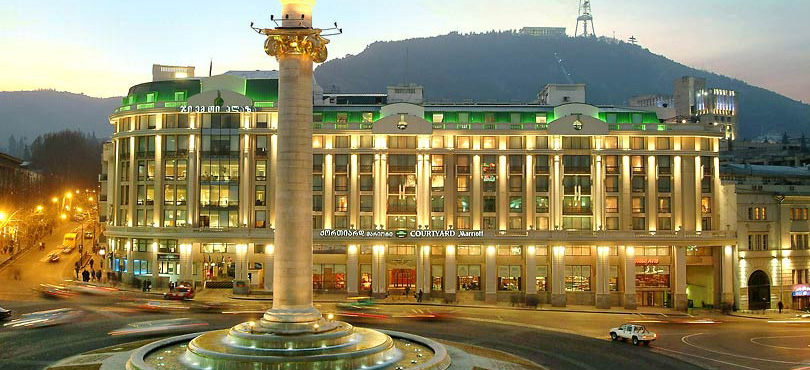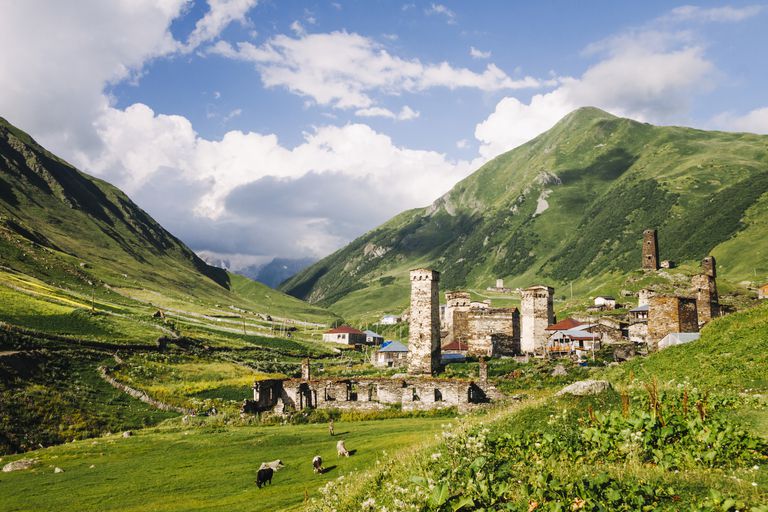Welcome to Georgia
 Georgia is a sovereign state in the Caucasus region of Eurasia. Located at the crossroads of Western Asia and Eastern Europe, it is bounded to the west by the Black Sea, to the north by Russia, to the south by Turkey and Armenia, and to the southeast by Azerbaijan.
The capital of Georgia is Tbilisi. Georgia covers a territory of 69,700 square kilometres (26,911 sq mi), and its population is almost 4.7 million. Georgia is a unitary, semi-presidential republic, with the government elected through a representative democracy.
During the classical era, independent kingdoms became established in what is now Georgia. The kingdoms of Colchis and Iberia adopted Christianity in the early 4th century. A unified Georgia reached the peak of its political and economic strength during the reign of King David IV and Queen Tamar in the 11th–12th centuries. At the beginning of the 19th century, Georgia was annexed by the Russian Empire. After a brief period of independence following the Russian Revolution of 1917, Georgia was occupied by Soviet Russia in 1921, becoming the Georgian Soviet Socialist Republic and part of the Soviet Union. After independence in 1991, post-communist Georgia suffered from civil unrest and economic crisis for most of the 1990s. This lasted until the Rose Revolution of 2003, after which the new government introduced democratic and economic reforms.
Georgia is a member of the Council of Europe and the GUAM Organization for Democracy and Economic Development. It contains two de facto independent regions, Abkhazia and South Ossetia, which gained limited international recognition after the 2008 Russo-Georgian War. Georgia considers the regions to be part of its sovereign territory under Russian military occupation.
The Five Cross Flag has a white background with a big red cross in the middle. The big cross is the cross of St George, the patron saint of Georgia. In each of the four white quadrants is a smaller red cross (the same color as the big one). The white of the flag represents peace, and the five crosses represent Christianity and sacrifice.
The flag was originally a banner from the medieval Kingdom of Georgia. It only became the modern-day flag in Georgia in January 2004. In 2003, protest erupted against the then president Eduard Shevardnadze. Instead of carrying guns or weapons, they carried roses and the Five Cross Flag. The flag is a symbol of the National Movement known as the Rose Revolution.
Georgia is a sovereign state in the Caucasus region of Eurasia. Located at the crossroads of Western Asia and Eastern Europe, it is bounded to the west by the Black Sea, to the north by Russia, to the south by Turkey and Armenia, and to the southeast by Azerbaijan.
The capital of Georgia is Tbilisi. Georgia covers a territory of 69,700 square kilometres (26,911 sq mi), and its population is almost 4.7 million. Georgia is a unitary, semi-presidential republic, with the government elected through a representative democracy.
During the classical era, independent kingdoms became established in what is now Georgia. The kingdoms of Colchis and Iberia adopted Christianity in the early 4th century. A unified Georgia reached the peak of its political and economic strength during the reign of King David IV and Queen Tamar in the 11th–12th centuries. At the beginning of the 19th century, Georgia was annexed by the Russian Empire. After a brief period of independence following the Russian Revolution of 1917, Georgia was occupied by Soviet Russia in 1921, becoming the Georgian Soviet Socialist Republic and part of the Soviet Union. After independence in 1991, post-communist Georgia suffered from civil unrest and economic crisis for most of the 1990s. This lasted until the Rose Revolution of 2003, after which the new government introduced democratic and economic reforms.
Georgia is a member of the Council of Europe and the GUAM Organization for Democracy and Economic Development. It contains two de facto independent regions, Abkhazia and South Ossetia, which gained limited international recognition after the 2008 Russo-Georgian War. Georgia considers the regions to be part of its sovereign territory under Russian military occupation.
The Five Cross Flag has a white background with a big red cross in the middle. The big cross is the cross of St George, the patron saint of Georgia. In each of the four white quadrants is a smaller red cross (the same color as the big one). The white of the flag represents peace, and the five crosses represent Christianity and sacrifice.
The flag was originally a banner from the medieval Kingdom of Georgia. It only became the modern-day flag in Georgia in January 2004. In 2003, protest erupted against the then president Eduard Shevardnadze. Instead of carrying guns or weapons, they carried roses and the Five Cross Flag. The flag is a symbol of the National Movement known as the Rose Revolution.
Why the country is called Georgia
There is no conclusive evidence as to how Georgia got its name. There is believed to be a direct link to St George. In fact, there is a golden statue of the saint slaying a dragon in Tbilisi Central Square. St George is the Patron Saint of Georgia and is believed to have been sentenced to death for refusing to renounce his Christianity. It’s important to note that Georgians don’t call their country by its English name. Locals refer to it as ‘Sakartvelo’, translated to “the place where the Kartvels – Georgians – are living”Georgian cuisine
Georgia may be a small country, but there is an abundance of interesting and delicious food. One of the most notable is ‘shotis puri’. The traditional bread is made in a round clay oven (known as a ‘tone’). The dough is then stuck around the walls of the oven and baked. Only skilled bakers are able to achieve the delicious bread. The oven needs to be hot and the dough sticky enough to stay glued to the sides. Another intriguing treat in Georgia is ‘Churchkhela’, the uniquely candle-shaped candy. The main ingredients are nuts, flour and grape must. The skewers are dipped in thickened grape juice and then dried in a sausage form. Population 4.3 millionArea 69,700 sq km (26,911 sq miles)
Major languages Georgian, Russian widely spoken
Major religion Christianity
Life expectancy 71 years (men), 77 years (women)
